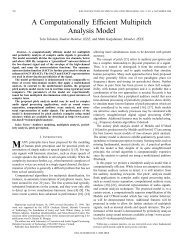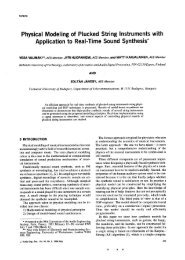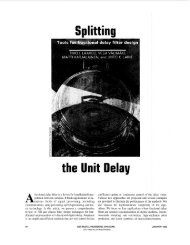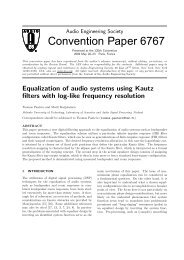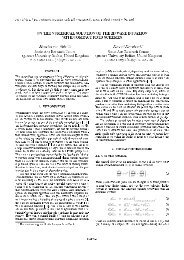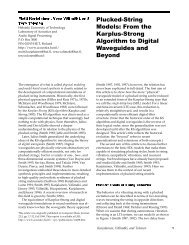Evaluation of learning in computer based education using log ...
Evaluation of learning in computer based education using log ...
Evaluation of learning in computer based education using log ...
- No tags were found...
You also want an ePaper? Increase the reach of your titles
YUMPU automatically turns print PDFs into web optimized ePapers that Google loves.
Session 12a3EVALUATION OF LEARNING IN COMPUTER BASED EDUCATIONUSING LOG SYSTEMSMartti Rahkila and Matti Karjala<strong>in</strong>enHels<strong>in</strong>ki University <strong>of</strong> Techno<strong>log</strong>yLaboratory <strong>of</strong> Acoustics and Audio Signal Process<strong>in</strong>gI! 0. Box 3000FIN-U201 5 HUT F<strong>in</strong>landMartti.Rahkila@hut.fi, Matti.Karjala<strong>in</strong>en~hut:.fihttp://www.acouaticsl.hut.fi/ABSTRACT<strong>Evaluation</strong> is llifliculr but importantpart <strong>of</strong> leuvti<strong>in</strong>g to bathmchcrs nad siudents. This paper discusses the idcn <strong>of</strong> us<strong>in</strong>g<strong>log</strong> systerns to collect <strong>in</strong>formation ira Compiirer Baaed Education(CBE}. The <strong>log</strong> <strong>in</strong>formation can be ai<strong>in</strong>lyzed and usedtogether or cvcn <strong>in</strong>stead <strong>of</strong> traditional evnli<strong>in</strong>tiota measures.Furtlierniore, <strong>in</strong> terms <strong>of</strong> self-study CBE mnter<strong>in</strong>l. <strong>log</strong>g<strong>in</strong>gcan he beraeficially applied to <strong>in</strong>teractively control Icnniirig.As n special case <strong>of</strong> <strong>in</strong>terest, methods fur m<strong>in</strong>g WWW <strong>log</strong>systenn <strong>in</strong> learli<strong>in</strong>g evaluation as well as advanced structuresfor <strong>in</strong>teractive WWW-<strong>based</strong> edimuion are discussed1. INTRODUCTIONthwc cases arc illustrated with examples from CBE applications.As a special casc <strong>of</strong> <strong>in</strong>terest, WWW and its <strong>log</strong> systemare discussed. All current WWW servers <strong>in</strong>clude a <strong>log</strong>g<strong>in</strong>gmechanism and this <strong>in</strong>formation could be used for cvaluat<strong>in</strong>gWWW-<strong>based</strong> <strong>education</strong>. A standard WWW server <strong>log</strong>system is thoroughly discussed and evaluated what can andwhat can’t be analyzed from that data. Methods such as userauthentication or HTTP cookie tcchniques and their use forthe identification <strong>of</strong> users are exam<strong>in</strong>ed. Furthermore, it isshown how <strong>log</strong>g<strong>in</strong>g can be utilized for <strong>in</strong>teractive user control<strong>in</strong> an advanced WWW-<strong>based</strong> <strong>education</strong> system.2. EVALUATION OF LEARNINGThe evaluation <strong>of</strong> <strong>learn<strong>in</strong>g</strong> is without a doubt <strong>of</strong> <strong>in</strong>terest toevery teacher. However, it is vcry difficult to develop any objectiveor technical measures to it. After all, <strong>learn<strong>in</strong>g</strong> evaluationconta<strong>in</strong>s also philosophical aspects such as what <strong>learn<strong>in</strong>g</strong><strong>in</strong>herently is. Still, teachers have throughout years developedand used some criteria to estimate thcir work results.The traditional methods <strong>in</strong>clude exam<strong>in</strong>ations and fecdbackforms. However, Computer Based Education (CBE) allowsanothcr possibility, <strong>log</strong>g<strong>in</strong>g, that is, gather<strong>in</strong>g <strong>in</strong>formationand analyz<strong>in</strong>g user’s actions, to be used together withor even<strong>in</strong>stead <strong>of</strong> tho traditional methods.This paper discusses the pros and cons <strong>of</strong> the traditionalmethods and presents the concept <strong>of</strong> <strong>log</strong>g<strong>in</strong>g from cducationalpo<strong>in</strong>t <strong>of</strong> view. Three majar uses for <strong>log</strong>g<strong>in</strong>g are presented:1) us<strong>in</strong>g <strong>log</strong>s (files) as a teacher’s reference to evaluate<strong>learn<strong>in</strong>g</strong> process, 2) us<strong>in</strong>g <strong>log</strong>g<strong>in</strong>g (memory) to <strong>in</strong>teractivelyguide users <strong>in</strong> multimedia, self-study CBE applications,and 3) us<strong>in</strong>g <strong>log</strong>s (files and memory) to give users apossibility to exam<strong>in</strong>e their own progrcss and automaticallygenerate reports <strong>in</strong> multimerl<strong>in</strong>-<strong>based</strong>, self-study CBE. All-The evaluation <strong>of</strong> <strong>learn<strong>in</strong>g</strong> is a difficult but extremely importantpart <strong>of</strong> develop<strong>in</strong>g courses and teach<strong>in</strong>g methods. Themotivat<strong>in</strong>g effect is obvious. But equally or even mnrc importantthan it is to a teachor, it is to a studcnt to evaluatc andmeasure their progress. Only by feedback students are ableto understand the quantity or quality <strong>of</strong> their <strong>learn<strong>in</strong>g</strong>. However,the question <strong>of</strong> <strong>learn<strong>in</strong>g</strong> evaluation is far from be<strong>in</strong>gsimple: How to measure if a student has learned someth<strong>in</strong>gand if so, what would it be? At the vcry end, the questionis not <strong>of</strong> f<strong>in</strong>d<strong>in</strong>g a suitable criteria but B philosophical one:What is <strong>learn<strong>in</strong>g</strong>?A wide variety <strong>of</strong> methods for evaluation, assessment,comparison etc. <strong>of</strong> <strong>learn<strong>in</strong>g</strong> has been presented <strong>in</strong> the literature,for both come and curriculum level. It is not with<strong>in</strong>the scope <strong>of</strong> this paper to cavcr these nil, but two commoncourse-level mcthods are discussed.Perhaps the most traditional metliud <strong>of</strong> evaluat<strong>in</strong>g <strong>learn<strong>in</strong>g</strong>at coursc level is an exam<strong>in</strong>ation. In this method, the teachercreates a test and students take it. After that, the teacher evaluatesanswers RS correct, <strong>in</strong>correct or someth<strong>in</strong>g <strong>in</strong> between0-7803-564.7-8/99/$10.000 1999 IEEENovember 10 - 13,1999 San Junn, Puerto Rico29th ASEEILEEE Froiitiers ill Education Conference12a3-16
Session 12a3f<strong>in</strong>d f<strong>in</strong>ally describes theresults as numbers. Thc student canthen co<strong>in</strong>pare hislhcr results to ail ubsolute scalo or to results<strong>of</strong> others and thus evaluate their perforrnancc. The teacher,on thc other Iiand, tnkes the avcrage results and uses themfor an estimate <strong>of</strong> the overall <strong>learn<strong>in</strong>g</strong> <strong>of</strong> the students hk<strong>in</strong>gthe exam<strong>in</strong>ation. But can we really say that these resultsdescribe Icarn<strong>in</strong>g? If the test wils cleverly designcd, probablyyes, at least to some extent, but <strong>in</strong> general this methodis far too dependent <strong>of</strong> the test itself, the course, the goals.the material etc. Often thc situation is that the teacher has toadjust the overall scale leav<strong>in</strong>g noth<strong>in</strong>g but a hunch <strong>of</strong> trueevaluation <strong>of</strong> <strong>learn<strong>in</strong>g</strong>. Still, thcre is no need to abandon cxam<strong>in</strong>ationswithout carefully considerat<strong>in</strong>g it first. Despitetheir problems, exam<strong>in</strong>ations are vcry <strong>of</strong>ten tlic only practicalalternative.Another commonly uscd method with courses is a feedbackform. Students are givcn R form and they are expectedto use it to evaluate their own <strong>learn<strong>in</strong>g</strong> and/or course withsome k<strong>in</strong>d <strong>of</strong> predef<strong>in</strong>ed scale or by short written answers. Itis customary that when a form is used together with an exam<strong>in</strong>ation,they do not affect course grad<strong>in</strong>g and usually thereis a possibility to ft~lfill and return the form imonymously.Unfortunately, <strong>of</strong>tcn the feedback forms have been designedonly from the viewpo<strong>in</strong>t <strong>of</strong> A teacher and the benefit <strong>of</strong> fulfill<strong>in</strong>gonc rema<strong>in</strong>s unclear for a student. There are exceptions,<strong>of</strong> course, and a well designed feedback form can give bothstudents and teachers equally uscfiil <strong>in</strong>formation far <strong>learn<strong>in</strong>g</strong>cvnluation.There are also morc advanced methods such as course assignments,laboratory experiments etc. that give a studcnt npossibility lo apply thc th<strong>in</strong>gs that thcy have learned. Thecourse assignments ccrta<strong>in</strong>ly give a mare accurate estimate<strong>of</strong> the lean<strong>in</strong>g, but for tcnchers, it is sometimes impossible10 organize such <strong>in</strong> practice. Comb<strong>in</strong>ations <strong>of</strong> the methodsdescribed can also be beneficial, see for example [2].3. THE CONCEPT OF LOGGINGIn cornpatcr science, <strong>log</strong>g<strong>in</strong>g is normally considered as sav<strong>in</strong>guser or debug <strong>in</strong>formation to a file. It is il very much standardtechnique to 1) calculate the usagc <strong>of</strong> the s<strong>of</strong>tware and2) tracc back possible problem situations. In client-serverapplicst<strong>in</strong>ns, <strong>log</strong>g<strong>in</strong>g is a very solid and natural part <strong>of</strong> thesystem, hccnuse much <strong>of</strong> the <strong>log</strong> <strong>in</strong>formation t<strong>in</strong>s to bc exchangedbetween the client and the scrver anyway. Thcrefore,for examplo all common Internet services like WWW,ftp, cmail etc. <strong>in</strong>clude a <strong>log</strong> systcm.Hnwcvcr, <strong>in</strong> this paper, the concept OF <strong>log</strong>g<strong>in</strong>g should beunderstood <strong>in</strong> a more general way: as exchang<strong>in</strong>g and stor<strong>in</strong>g<strong>in</strong>formation. Thc <strong>in</strong>formation can then be saved <strong>in</strong>to afile or only kept <strong>in</strong> B memory while an ~pplication is used,depend<strong>in</strong>g on what it is used far. What <strong>in</strong>formation is <strong>in</strong> thissense <strong>log</strong>ged also depcnds on a particular application wenthough common parameters defioitcly cxist. Thus thc concept<strong>of</strong> lugg<strong>in</strong>g should actually be thought <strong>of</strong> as <strong>in</strong>clud<strong>in</strong>guser related mefadata with the orig<strong>in</strong>al <strong>in</strong>formation.It should be noted that the concept <strong>of</strong> <strong>log</strong>ghgmay <strong>in</strong>cluderestrictions by law. In some countries and <strong>in</strong> certa<strong>in</strong> type <strong>of</strong>services or applications, <strong>log</strong>g<strong>in</strong>g is regarded obligatory bylaws and <strong>in</strong> somc countries, even the same ones, the lawsprohibit any <strong>log</strong>g<strong>in</strong>g that may expose or relate to persons’trite identity.Therefore, whenever a <strong>log</strong> system that authenticates usersis used, the authentication mechanism should not relate toperson‘s trire identity but primarily identify and dist<strong>in</strong>guishthe users from each other and secondarily identify they RS<strong>in</strong>dividual persons. In the field<strong>of</strong> <strong>education</strong> this <strong>in</strong> fact couldbe a problem, th<strong>in</strong>k <strong>of</strong> for example electronic exam<strong>in</strong>ations.Still, quitc <strong>of</strong>ten it is only desired to dist<strong>in</strong>guish the studentsas <strong>in</strong>dividual students rather than true, <strong>in</strong>dividual persons <strong>in</strong>legal sence.4. LOGS AS TEAC€Il?.R’S REFERENCEIn 1994- 1995 a tritorial lcvcl CBE application, “Introduclionlu Signal P[-uucsssilig” [ 11 was developed at the IldsiiikiUniversity <strong>of</strong> Techno<strong>log</strong>y, Laboratory <strong>of</strong> Acoustics and AudioSignal Process<strong>in</strong>g. The application is a multimediaself-study package. but it has been used as a part <strong>of</strong> thecourse “Fundamentals <strong>of</strong> Acoustics I” which is the veryfirst acoustics coiirse for students. “Introduction to SignalProcess<strong>in</strong>g” is an Apple Mac<strong>in</strong>tosh application and studentsused the program <strong>in</strong> a dedicated workstation located <strong>in</strong> thelaboratory.The application consists <strong>of</strong> “pages” (w<strong>in</strong>dows) with eitherstatic <strong>in</strong>formation, <strong>in</strong>teractive demonstrations Or questions,and “chapters”, collections <strong>of</strong> pages that cover a certa<strong>in</strong> topic. The studcnts were allowed to go through thcsetopics <strong>in</strong> any order they wished, but there was also a defaultpath that could be followed. From thc very beg<strong>in</strong>n<strong>in</strong>guT thr: development project it was clear that <strong>in</strong>formatiou wasneeded ta cvsluate llie SLICCCSS :<strong>in</strong>d (isage <strong>of</strong> this CBE npplication,From tcachec’s po<strong>in</strong>t <strong>of</strong> view, the questions <strong>of</strong> <strong>in</strong>terest<strong>in</strong>cluded:4 How much time would the students spend with it?How much material would they go through?4 In which order would the studcnts study subtopics?Are them pagesitopics that students would spend n lotmorc time on than nthcrs?Are tliere pogos/topics that students would skip’?What is the aver:igc time students spend on the application or page’?0-7803- 5643 - 8/99/$10.00 @ 1999 1 E EUNovernhcr 10 - 13,1993 San Jt<strong>in</strong>ii, Puerto Rico29th ASEWIEEE Frontiers <strong>in</strong> Ediicatioii Conference12 a3 -17
Session 12a3I Would the students take the default path or would theyuse tho possibility to study the topics <strong>in</strong> same other order?In order to get answers to thesc questions, a <strong>log</strong> systemwas implemented <strong>in</strong>to the application. The follow<strong>in</strong>g <strong>in</strong>formationwas <strong>log</strong>ged:<strong>log</strong><strong>in</strong>: course name, username, studentnumber, date, time0 page open: symbol name <strong>of</strong> the page,universal timepage close: symbol name <strong>of</strong> the page,universal timeIsgout: timeTlic <strong>in</strong>formation WRS saved as text and later imported toa sprcadsheet program for detailed analysis. After us<strong>in</strong>g theapplication, students were also cncouraged to fill <strong>in</strong> a feedbackform that conta<strong>in</strong>ed questions related to both the contentsand the implementation.The use oC“In1wduction tu Sigiial Prucessirig” was esstiit<strong>in</strong>llyonly a small part <strong>of</strong> a regular course that <strong>in</strong>cluded itnexam<strong>in</strong>ation as the primary course evaluation method. Thcapplication was not <strong>in</strong>tended to replace any other course orcoiirse material but to provide additional material to the regularacoustics course. Thc CBE-material was not <strong>in</strong>cluded<strong>in</strong> the course exam<strong>in</strong>ation and that is why the evaluation hadto be <strong>based</strong> on some other method. Therefore, <strong>in</strong> ordcr toestimate <strong>learn<strong>in</strong>g</strong> with the CBE-application, the <strong>log</strong>s wereanalyzed and two criteria chosen as <strong>learn<strong>in</strong>g</strong> measures: theoverall time a student spent with the program and the amount<strong>of</strong> pages fitudent browsed. These criteria were given m<strong>in</strong>imumvalues <strong>based</strong> on thecontents. Students who spent moretime and went through more pages than the m<strong>in</strong>imum values,were given additional po<strong>in</strong>ts <strong>in</strong> the exatn<strong>in</strong>ation (5 YO <strong>of</strong> the~naxi~riuiri). Wedbwk him (paper) weir. usrd as a backupmethod to ensure <strong>log</strong> evaluation results especially <strong>in</strong> possiblcproblem situations.The CBE-application be<strong>in</strong>g a separate, self-study cxperimentwithout any relation to previous or parallel matcrialprevents a thorough, compardve analysis to be <strong>in</strong>cluded.However, the overnll results from the first group <strong>of</strong> students(approx. 80) are as follows: A comparison <strong>of</strong> the results<strong>of</strong> the fccdback form analysis and the <strong>log</strong> analysis clearlyshowed that students who really concentrnted and spent timewith the CBE-application. actually learned somcth<strong>in</strong>g fromit and that the chosen criteria would be suitable for <strong>learn<strong>in</strong>g</strong>evaluation. Additional <strong>log</strong> analysis results like averagetime spent on a page sliowerl that students spent more timeon pages that conta<strong>in</strong>ed <strong>in</strong>teractive material but otherwise nomajor dil‘Cerellces betwccn he puges could bt: Fuurid. However,this k<strong>in</strong>d <strong>of</strong> result was rather expected <strong>in</strong> the orig<strong>in</strong>aldesign goals for this CBE-application.5. LOGS AS IN’1’EKACTIVE; GUIDESThe “Introduction to Signal Process<strong>in</strong>g” conta<strong>in</strong>ed also another<strong>log</strong>g<strong>in</strong>g mechanism: it kept the <strong>in</strong>formation <strong>of</strong> visitedpages <strong>in</strong> memory. Because the p ap were divided <strong>in</strong>to tcipicspecificgroups (chapters), it was pnssible CO keep track <strong>of</strong>tho chapters and autfimatically suggest users with topics thatthcy hod not covered yet. Furthermore, thc visited pageswere also attached tu navigation history thus allow<strong>in</strong>g siudentsto refer to any page they had already visited.In sclf-study, multimedia CBE, such behavior is very usefulbecause it allows the application itself to suggest the studentwhnt topics hckhe should study next and, furthe.rmore,relationships betwecn topics to be <strong>in</strong> control <strong>of</strong> the CBE devcloper,that is, the teacher.“Introduction to Signal Proccss<strong>in</strong>g” utilized this behaviorby conta<strong>in</strong><strong>in</strong>g an irilerictivt: expuiment that students wereallowed to explore only after all topics had becn covered.Thc cxperiment itself comb<strong>in</strong>ed <strong>in</strong>formation fmm the othertopics. In general, this k<strong>in</strong>d <strong>of</strong> control is somewhat essential<strong>in</strong> self-study CBE to make sure students have the necessarybackground <strong>in</strong>formation before mov<strong>in</strong>g on to mme advancedmaterial. It is also uscful <strong>in</strong> case <strong>of</strong> electronic exam<strong>in</strong>ations.6. LOGS AS STUDENT’S REPI3RHENCEIf a CBE-application conta<strong>in</strong>s lots <strong>of</strong> material or the materialconsists <strong>of</strong> different topics related to each other, it is necessaryto give studcnt a possibility to estimate how much thcyhave done alredy and how much they still have to do <strong>in</strong> ordertn cnvcr dl or certa<strong>in</strong> amount <strong>of</strong> the material. One usefilltoul for that is the previously mentioned navigation history,but “Introduction to Signal Process<strong>in</strong>g” conta<strong>in</strong>ed also anothertool for this: the status w<strong>in</strong>dow.After <strong>log</strong>g<strong>in</strong>g <strong>in</strong>, thc studcnt could, at any stagc. choose“Status” from a menu. The stiltus w<strong>in</strong>dow then presented <strong>in</strong>fnrmationsuch as Ihc topics already covered, the topics todo and total time spent so far. It could have also <strong>in</strong>cludedcomplex estjmates like a time estimate how long it wouldtake For a student to study everyth<strong>in</strong>g (<strong>based</strong> [m the average“spced”) etc. but such were not implcmcnied <strong>in</strong> “Introductiontn Signal Process<strong>in</strong>g”.From the po<strong>in</strong>t or view <strong>of</strong> self-evaluat<strong>in</strong>n <strong>of</strong> leatn<strong>in</strong>g, thestatus tool is very useful and nt its best quite accurate, depend<strong>in</strong>g<strong>of</strong> course 011 the particular CBEnpplication.Another <strong>in</strong>terest<strong>in</strong>g idea is tn use <strong>log</strong>g<strong>in</strong>g for automoticallygencrat<strong>in</strong>g reports, An cxample <strong>of</strong> this type <strong>of</strong> use was<strong>in</strong>cluded <strong>in</strong> B “Psychoacoustics” CBE-package [I] I The applicationconta<strong>in</strong>ed theory and demonstrations <strong>of</strong> psychoacuustjcalphmurIieiia <strong>in</strong> the limn dlisten<strong>in</strong>g tests. The studentscould for <strong>in</strong>stance merrsurc their own frequency mask<strong>in</strong>gcurves by perform<strong>in</strong>g a series <strong>of</strong> listen<strong>in</strong>g tests. The au-0.7803-5643-8/99/$10,00 @ 1999 IEEENovember 10 - 13,1999 San Juan, Puerto Rico29th ASEEflEEE Frontiers <strong>in</strong> Education Confcrcncc12a3- 18
Session 12a3tomatically generated rcport <strong>in</strong> this case was student's ownfrequency mask<strong>in</strong>g curve, which helshe could easily comparewith theoretical results.The automatic report generat<strong>in</strong>g is a useful concept <strong>in</strong>every CBE application that <strong>in</strong>volves measurements (real orsimulated) or testlqucstion-like <strong>in</strong>teractivity.The studcnts can also be given access to their own <strong>log</strong>files afterwards. Analyz<strong>in</strong>g the <strong>log</strong>s by themselves wouldeasily po<strong>in</strong>t out issues and topics thnt were not thoroughlyexam<strong>in</strong>ed and cstimate what topics should bc given furthernotice. Basically, the analysis could be similar to the oneteachers pcrfnrrn, but <strong>in</strong> this case, it would only evaluate the<strong>learn<strong>in</strong>g</strong> process <strong>of</strong> an <strong>in</strong>dividual student.7. WWW LOG SYSTEMIn the last few years, the WWW (World Wide Web) has becomeperhaps the most important tool for CBE. From thevery beg<strong>in</strong>n<strong>in</strong>g, WWW scrvcrs (httpd) havc <strong>in</strong>cluded a <strong>log</strong>g<strong>in</strong>gmcchanism as well. Like many other Internet services,the httpd <strong>log</strong> system has been designed ma<strong>in</strong>ly for "hit-rate"type statistical analysis or debugg<strong>in</strong>g purposes, but <strong>in</strong> hctit is one <strong>of</strong> the most flexible and well-designed <strong>log</strong> systemsaround.To be precise, the WWW <strong>log</strong> systcm is a sum <strong>of</strong> threecomponents: 1) the server s<strong>of</strong>tware, 2) the client s<strong>of</strong>twareand 3) the HI'l'P protocol. The <strong>in</strong>formation that is written tothc <strong>log</strong> depends on thc server s<strong>of</strong>twarc and also the paramctersthnt are sent by the browser. 'I'he <strong>in</strong>formation exchangeis done withiti thc c~pabilities <strong>of</strong> the HTTP protocol [4].A typical httpd <strong>log</strong> cunta<strong>in</strong>s (example takcn from thedocumentation <strong>of</strong> one <strong>of</strong> thc most popular WWW-servers.apache (http://ww. apache. orq/)):host ident authuscr date request stntns byteswhcrc the tokens archost The fully~qiialifiecl doma<strong>in</strong> name <strong>of</strong> the client, orits IP number if the name is not avoilnble.idcnt IT IdentityCheck is enabled and the client mach<strong>in</strong>eruns itlentcl; then this is the identity <strong>in</strong>formationrcported by the client.authiiser If the rcqucst was for n password protectedducumcnt, then this is thc userid used <strong>in</strong> thc request.date The date and time <strong>of</strong> the request, <strong>in</strong> fonnntdaylmonthlyemhour: m<strong>in</strong>ute:second zonerequest The request l<strong>in</strong>e (url) from the client, enclosed<strong>in</strong> double quotes (").status The thrcc digit status codc rcturnerl to the clicnt.bytes The number <strong>of</strong> bytcs <strong>in</strong> the object returned to theclient, not <strong>in</strong>clud<strong>in</strong>g any hcaders.1fa token docs not have a value then it is represented by ilhyphen (-1.The above is called Common Log Format (CLF) and the<strong>in</strong>Formation is written to so called TransferLog. Apacheserver also has a possibility to use customized <strong>log</strong> formatswith a number <strong>of</strong> additional keywords. Howcvcr, the CLF assuch is adequate for most purposes except for two particulartokens, Refercr and User-Agent. The Refercr is the url tuthe page from where the user came from (via HTML-l<strong>in</strong>k)and User-Agent, an id-str<strong>in</strong>g <strong>of</strong> the browscr s<strong>of</strong>tware send<strong>in</strong>gthe request. Apache server can bo configured to storethese directly to TransferLog with custom <strong>log</strong> commands"W{Refcrcr}i" and "%{User-Agent}i". Errors are usuallywritten to a separate ErrorLog with similar <strong>in</strong>formntion tpossibly scime deiails <strong>of</strong> the error itself.The <strong>log</strong> systems <strong>in</strong> other WWW-servers vary both <strong>in</strong>format and <strong>in</strong> customisability but thc differences are quitesmall.On a busy server the <strong>log</strong> files easily become very big andthus difficult to handle. Hence there is a number <strong>of</strong> specializcdWWW <strong>log</strong> analysis tools available, for <strong>in</strong>stance nndog(http://www.statslab.cam.ac.uk/"sretl/ana<strong>log</strong>/)or WUmp (http://www.boutell .com/wusage/). Themost advanced ones are very fast and customiznble <strong>in</strong> terms<strong>of</strong> analysis paramctcrs and <strong>in</strong>put or output format, butusually they provide only basic statistical measiires such ashit rates etc.8. LEARNING EVALUATION WITH WWW LOGSYSTEMFrom the po<strong>in</strong>t <strong>of</strong> view <strong>of</strong> <strong>learn<strong>in</strong>g</strong> evaluation, it is importantto notice that the basic <strong>log</strong>g<strong>in</strong>gmakes it somewhat irnpossibleto tracc back <strong>in</strong>dividual users' requcsts. A standardsolution is to use authentication to restrict access tothe contents. Most WWW servers and brnwsers supportauthentication and <strong>in</strong> its simplest form, uscr ;iuthenticationis easy to implcmcnt. Usually nuthenticat<strong>in</strong>n <strong>in</strong>volves alsoaccount management, preferably as automatic as possible,which is not simple to implement (not be<strong>in</strong>g very difficultcither, though). A gouood management system would allowstudents (or anyone) to register on-l<strong>in</strong>e and create the necessaryaccount immediately as well as methods for tak<strong>in</strong>g care<strong>of</strong> chang<strong>in</strong>g password or remov<strong>in</strong>g account. If user authenticationis used, it is possiblc to do <strong>of</strong>f-l<strong>in</strong>e evniuation andannlysis similar io one presented <strong>in</strong> section 4.Another disadvantage <strong>of</strong> the basic WWW <strong>log</strong> systcrn isthat the <strong>in</strong>formation is writtcn only on B request basis. loput it <strong>in</strong> other words: it doesn't remember anyth<strong>in</strong>g. In orderto use <strong>log</strong>g<strong>in</strong>g for purposes such as <strong>in</strong>teractive guidanceor on-l<strong>in</strong>e evnluation, morc advanced techniques arc needed.Two basic solutions are available: 1) produc<strong>in</strong>g thc contentNovember 10 I 13,1999 San Juan, Puerto Rico29th ASEWIEEE Fronticrs <strong>in</strong> Education Confcrciice12a3-19
Session 12a3dynamically (on the server) so that appropriate metadata ci<strong>in</strong>be <strong>in</strong>cluded as for examplc hidden <strong>in</strong>put fields etc. and 2)I-ITTP Cookies [5] that are small <strong>in</strong>formation fragments tmvd<strong>in</strong>gwith I-ITTP headers.The former method, produc<strong>in</strong>g contents dynamically supersedesthe latter, cookies, <strong>in</strong> various aspects. Perhaps themost important one is reliability; not all browsers supportcookies at all and, even if they do, the user can deliberatelydeny their use. Cookies are also very limited <strong>in</strong> their cnpnbilities<strong>of</strong> carry<strong>in</strong>g <strong>in</strong>formation, for <strong>in</strong>stance, the size <strong>of</strong> acookie can not exceed 1024 bytes. Still, cookies are verycommon and used especially for track<strong>in</strong>g tim<strong>in</strong>g or users'paths when brows<strong>in</strong>g through a WWW site.Produc<strong>in</strong>g the contents dynamically allows the developer(teacher) tu have all the <strong>log</strong> <strong>in</strong>formation available anytimcand furthermore, to specify what metadata and how it is <strong>in</strong>duded<strong>in</strong> the real contents. There arc drawbacks too: it ismuch more difficult for a devclopcr to create dynamic contentsthan static WWW pilges and it always takcs more computationalresources from thc server.A widc variety <strong>of</strong> implementation techniques can beusd. CGt (Common Gateway Interface), apachc moduletechniques(mod-pd. modphp, etc.), Java Servlets and soan. Also, <strong>in</strong> order to manage large amount <strong>of</strong> data, that isCBE-material as WWW pages, a ditilbase <strong>of</strong> some k<strong>in</strong>d isnceded too. SQL or text databases seem to be the most popularchoices at the moment.It should be noticed that, <strong>in</strong> pr<strong>in</strong>ciple, client-side idcractivitytechniques such as Java Applets or script<strong>in</strong>g languagesdo not provide <strong>log</strong> <strong>in</strong>formation from the process<strong>in</strong>g itself.This is due to the fact that the WWW <strong>log</strong> system is <strong>based</strong> on<strong>in</strong>teraction betwccnclient and server and client-side process<strong>in</strong>gbasically does not <strong>in</strong>volve server for other than provid<strong>in</strong>gthe code itself.9. EXAMPLE ANALYSISConsider the follow<strong>in</strong>g (sirnplificd) <strong>log</strong> data:IP1IP1I P2IP1IP2IP1IP1I P2IPluserluserluser2userluser2userluserluserauserlt imelt ime2time3t irne4time5time6time7time8time9urll codeurl2 codeurZl codeur13 codeur12 codeur14 codeurLs codeur37 codeur16 codesizesizesizesizesizesizesizesizesizeFrom that data, imrnidiately can be calculated:reEOref1ref0ref2ref1ref3ref4ref2ref 5What pages have userl and user2 visited?What path have they followed?brwsrbrwsrbrwsrbrwsrbrwsrbrwsrbrwsrbrwsrbrwss+ What is the amount <strong>of</strong> lime they hnve spent onpagclpages'! (see notc below)e Have they connected from local network, i.e., used forcxample <strong>computer</strong>s provided by schoolluniversity (1Paddress)?What WWW-browser s<strong>of</strong>tware have they used?As themselves, the results arc not very descriptive, but ifthese measures and iirls are mapped with respect to thc CBEmaterial they present, they can be <strong>of</strong> great value <strong>in</strong> <strong>learn<strong>in</strong>g</strong>evaluation. For example, we can observe that userl hasstudied 6 pages (topics), spent certa<strong>in</strong> amount <strong>of</strong> time on apagelpages, has followed il l<strong>in</strong>ear path, has used a certa<strong>in</strong>WWW-browser and cornpiiter coniiectcd to university localnetwork. User2 on the other hand has studied 3 pagcs <strong>in</strong>certa<strong>in</strong> timc, has jiimped to a ncw iopic from pagc 2 and hasused university modem connections.Furthermore, if there is an <strong>in</strong>teractive task on page 4 thatrequires apply<strong>in</strong>g <strong>in</strong>formation from pagcs 1-3, it would <strong>in</strong>dicatethat user1 has <strong>in</strong>deed managed to overcome the taskand thus leanid that topic.It shnuld be noticed that because the WWW <strong>log</strong>-systemis <strong>based</strong> on requcst process<strong>in</strong>g, the tim<strong>in</strong>g is not accurate<strong>in</strong> certa<strong>in</strong> cascs. For <strong>in</strong>stance. users may jump to somc otherwebsite by typ<strong>in</strong>g <strong>in</strong> thc address directly, later return<strong>in</strong>g backto the orig<strong>in</strong>al page and the jump would not be seen <strong>in</strong> the<strong>log</strong>s. However, <strong>in</strong> many cascs il is reasonable to assume thatusers study <strong>education</strong>al material with concentration.Another important Feature <strong>of</strong> the WWW <strong>log</strong>-system is thatthe <strong>log</strong>g<strong>in</strong>g is always performed on the particular WWWserver conta<strong>in</strong><strong>in</strong>g the material. This means that if materialis distributed over a range <strong>of</strong> servers, thc <strong>log</strong> data needs tnbc comb<strong>in</strong>ed before analysis or advanced solutions like redirect<strong>in</strong>gneeds to be used.The f<strong>in</strong>al notice regrad<strong>in</strong>g this example is that if the CBEmaterial only conta<strong>in</strong>s basic or reference material, but notany <strong>in</strong>teractivity or tasks that require apply<strong>in</strong>g <strong>in</strong>formation,the <strong>log</strong>-<strong>based</strong> evaluation gives metadata type <strong>in</strong>formationthat is most useful when comb<strong>in</strong>ed with other evalnationmcthods. On the other hand, <strong>in</strong> case <strong>of</strong> sclf-study, <strong>in</strong>teractiveWeb-<strong>based</strong> <strong>education</strong>, the <strong>log</strong> analysis can provide avery good picture <strong>of</strong> the student's leaim<strong>in</strong>g process and thusbe used ils an evaluation mensure by itself.10. ADVANCED WWW STRUCTUXE'i'o USC <strong>log</strong>g<strong>in</strong>g for truc <strong>in</strong>teractive guidance, basically everys<strong>in</strong>gle web page lias to be turned <strong>in</strong>to a call for r program<strong>in</strong> the server. Onc solution (see Figurc 1) for this is lo usea User Agent to filter traffic between client and server [3],(Note: User Agent here is complctcly different from the onementioned <strong>in</strong> section 7).0-7803-5643-8/99/$10.00 @ 1999 IEEENovcrnber 10 - 13,1999 San Juan, Puerto Rico29th ASEE/lEEE Frontiers <strong>in</strong> Education Confercncc12~13 -20
Session 12a3Server I ClimtIIIIest <strong>in</strong> <strong>learn<strong>in</strong>g</strong> evaluation. Naturally, these would be casedependentparameters and certa<strong>in</strong>ly <strong>in</strong>orc difficult to implcment.Besides cvaluation <strong>of</strong> <strong>learn<strong>in</strong>g</strong>, <strong>log</strong>g<strong>in</strong>g is R very usefulconcept <strong>in</strong> other related areas as well. An example could bcpsycho<strong>log</strong>ical test<strong>in</strong>g, where it is sometimes cven mare i<strong>in</strong>portantto know how a person takes the test than whai hdsheanswered. Creat<strong>in</strong>g such test <strong>in</strong> an electronic form ratherthan traditional paper version, and <strong>in</strong>clud<strong>in</strong>g <strong>log</strong>g<strong>in</strong>g <strong>in</strong> thesyslem, would result <strong>in</strong> an cxtended set <strong>of</strong> material and, perhaps,<strong>in</strong>creased accuracy for psycho<strong>log</strong>ical evaluation.12. REFERENCESFigure 1: An advanced WWW architectureIn this structure, a User Agent represents the real user andtakes carc <strong>of</strong> all the requests made to thc server. It respondsto these requests with appropriate data accord<strong>in</strong>g to spccihcations made by the developer. Thus itrepresents the teacherits well and the nppropriate term <strong>in</strong> this case would be n DUMbleAgeng.There are a numbcr <strong>of</strong> ways to implement such architecture,but these are very sophisticated and far beyond thescope <strong>of</strong> this paper. In pr<strong>in</strong>ciplc, this type <strong>of</strong> structure allows<strong>log</strong>g<strong>in</strong>g to be applied <strong>in</strong> both <strong>of</strong>f-l<strong>in</strong>e evaluation and on-l<strong>in</strong>e<strong>in</strong>teractive control.13. CONCLUSIONSCompared to traditional methods, <strong>log</strong>-<strong>based</strong> evaluntion hascerta<strong>in</strong> advantages. Particularly, <strong>log</strong>s will <strong>in</strong>clude real <strong>in</strong>formation<strong>of</strong> the <strong>learn<strong>in</strong>g</strong> p~~occss itself, which is quite impossibleto expose with traditional methods like written exam<strong>in</strong>ationsnr assessment forms. The concept <strong>of</strong> <strong>log</strong>g<strong>in</strong>g alsosupports the cugnifive-conslr!tctive theory <strong>of</strong> <strong>learn<strong>in</strong>g</strong> I cl],prnvided that the CBE material itself was constructed <strong>in</strong> thismanner.Logg<strong>in</strong>g also adds ncw possibilities io student selfevaluation,which <strong>in</strong> university lcvel studies and studentorientedlearniiig is very importnnt. Furthermorc, <strong>log</strong>-<strong>based</strong>evaluation <strong>in</strong>cludes a strong dependency un the contents,same as cxam<strong>in</strong>ations and Fccdback forms. When used <strong>in</strong>comb<strong>in</strong>ation with cxam<strong>in</strong>ntions or fecdback forms, <strong>log</strong>g<strong>in</strong>gcan, however, provide a more accurate evaluation OF <strong>learn<strong>in</strong>g</strong>.Furlhermore, <strong>log</strong>g<strong>in</strong>gdoes not havc to be restrictcd to userand transaction relatcd data but morc content orientcd parameterscould be used as well. For example content descript<strong>in</strong>nsor content lcvcl would be parameters <strong>of</strong> <strong>in</strong>ter-[I] Karjala<strong>in</strong>en M., Rahkila M., “Learn<strong>in</strong>g signal process<strong>in</strong>gconcepts and psychoacoustics <strong>in</strong> the QuickSig DSPenvironment”, <strong>in</strong> Pmc. 1995 ?EEE Irrt. Con$ Acoust.,Speech, nnd Proc. (ICASSP’H), Detroit, Michigan,USA, vol2, pp. 1125-1128, May 9-12,1995.http://www.acoustics.hut.fi/”mara/publica~ions/icassp95/[2] Wiezel, A., “Measur<strong>in</strong>g thc success <strong>of</strong> virtual tutor<strong>in</strong>g”,<strong>in</strong> Proc. 1998 IEEE Frontiers <strong>in</strong> Education(FIE’98), Tempo, Arizona, USA, Nov 12-15,1978.http://€airway.ecn.purdue.edu/-€ie/~ieg~/papera/l357.pdf[3] Rahkila M., Karjala<strong>in</strong>en M., “An Experimental Architecturefor Interactive Web-<strong>based</strong> DSP <strong>education</strong>,” <strong>in</strong>Proc. I998 IEEE hit. Cot$ Acotrst., Speech, and Six.Proc. (ICASSP’98). Seattle, Wash<strong>in</strong>gton, USA, May12-15,1998. pp. 1857-1860,http://www.acoust;ics,hut.fi/-mara/publications/icasspga/[4] Field<strong>in</strong>g, R., et al., “Hypertcxt Transfer Protocol -HTTP/1.1”, RFC 2068, January 1997.ftp://ftp.isi.edu/<strong>in</strong>-notes/rfc206E.txt[5] Kristol, D., Mnntulli, L., “HTTF Statc ManagementMechanism”, EFC 2109, February 1997.ftp://ftp.isi.edu/<strong>in</strong>-notes/rfc2109.txt[6] Bruner, 1. S., “Tnwrrd n Theory <strong>of</strong> Instruction”, IhrvardUniversity Press, Cambridge, MA, USA, 1966.November 10 - 13,1999 San Juan, Puerto Rico29th ASEEIIKEE Frontiers <strong>in</strong> Education Conferencc12n3-21






